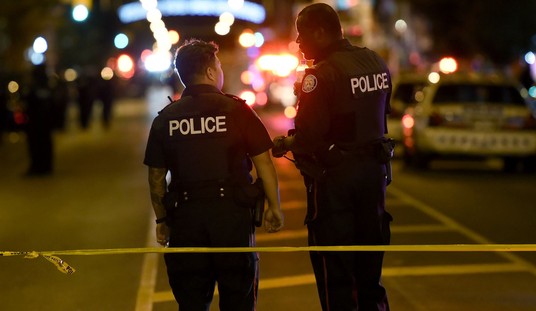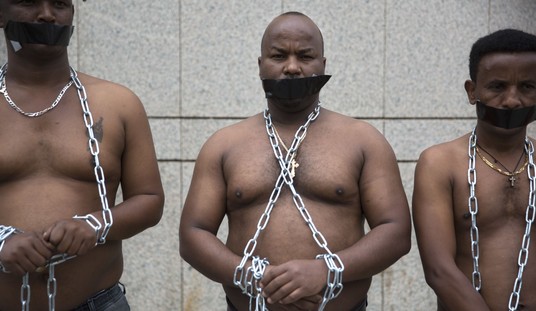Pajamas Media recently published an article by Todd Bensman (“Mexican Cartels Binge on American Bullets“) that bears discussing. While it makes an attempt to link high civilian ammunition demand here in the United States to violent crime performed south of the border by Mexican drug cartels, the article — and similar echoes adopted by the Obama administration and sympathetic journalists — is flawed.
5.7×28 ammunition is not “cop killer” ammunition, and its reputation as such among drug smugglers and gullible members of the media — the same media that dutifully reported Glock pistols were plastic “terrorist guns” that could evade metal detectors — is entirely unearned.
The armor-piercing steel core version (SS190) will only penetrate lesser soft body armor of Level IIA or lower, and will not penetrate Level III soft armor worn by most police agencies. It also certainly will not penetrate Level IV armor worn by military units, or armor equipped with soft or hard ballistic inserts or plates, or even Level IIA armor struck obliquely.
Further, SS 190 is not for sale to civilians in the United States, at any price, and the military and police agencies eligible to buy it largely ignore the round entirely due to poor terminal performance. Despite all the marketing, all the rumors, and all the hype, the 5.7×28 (muzzle velocity 2,050 fps, muzzle energy 255 ft-lbs) performs roughly the same as the .22 magnum (muzzle velocity 2,200 fps, muzzle energy 322 ft-lbs). I would prefer to never be shot, but if I ever were, I’d rather be shot with a 5.7×28 armor-piercing “cop killer” bullet than any standard centerfire handgun caliber commonly used in this country.
If any SS190 rounds are in the hands of cartels, odds are they are purchasing them from members of the Mexican law enforcement and military communities who see a chance to make a profit, and perhaps would rather be shot by this anemic cartridge in any of its loadings, instead of facing far more effective and proven rounds, such as all centerfire rifle ammunition and the overwhelming majority of common pistol calibers, such as 9mm, 40S&W, 357 SIG, 45ACP, and 38 Super.
Authors that choose to write about this subject should make a serious effort to separate the ammunition being purchased because of cartel use in Mexico from the vast majority of ammunition being purchased by and for Americans.
While Bensman cited anecdotal cases of captured smugglers, the overwhelming majority of bulk ammunition purchases in this country are from U.S. law enforcement and from civilian shooters that do not trust the current economic climate, the Democratic Party, or our present anti-gun administration.
A local North Carolina Wal-Mart sells 10,000-15,000 per shift if BoE employee counts are close to accurate, and a customer (white male) at the closest one purchased 5,600 rounds just two weeks ago. Ammo sales are through the roof everywhere in the United States, not just along the southern border. This author, like some of his peers, chooses to ignore this unquestioned reality in his pursuit of a story based more often on inferences and supposition than evidence.
Why are civilian ammunition sales so high presently? Because we have anti-patriotic men and women in positions of power extending all the way into the Oval Office itself that see civilian arms usage as a threat to their goals and somehow think that the Founding Fathers intended the Second Amendment to protect the rights of Americans to own arms, but not the ammunition needed to make those arms functional. Somehow I suspect journalists who so readily parrot that argument would be greatly alarmed if they were informed of entirely parallel restrictions to their First Amendment rights.
Perhaps they should be required to only spread ideas using quill and parchment; after all, that’s what the Founders had. They couldn’t have imagined high-speed modern printing presses, television, radio, or the Internet’s instant global reach.
Or perhaps they would eagerly submit to having a federal background check before being allowed to own an iPhone, BlackBerry, typewriter, computer, printer, or word-processing program, and would agree to the imposition of a 500-character limit on the amount of text they can type or words they can say before a government alert is triggered.
After all, if the pen is truly mightier than the sword, shouldn’t the dissemination of potentially inflammatory thought be regulated more tightly than mere ammunition?
Of course, these same journalists would fight such restrictions on their First Amendment right to free speech and having the tools to spread their thoughts, with all the ferocity they could muster against the cruel tyranny of a far too powerful, far too intrusive state. They’d likely want to take up arms themselves against a totalitarian state and its bureau of speech.
It’s too bad that under the same tyranny they encourage such arms could not exist.
Update — A response from Todd Bensman:
I don’t know about Mr. Owens, but when I buy .38 caliber practice rounds for my .357 Smith and Wesson, I plop down a credit card or write a personal check. I don’t walk around with $20,000, $30,000 or more in cash and neither do most police agency gun range procurement officers, legitimate hunters or shooting hobbyists. But if Mr. Owens wants to believe ammo bulk buyers all along the U.S. side of the Mexican border don’t have credit cards and checking accounts to pay their $10,000 or $20,000 bill at the Walmart counter … um … okay then. Mexican law enforcement officials, as well as American BATF people and federal border prosecutors, who spend all of their waking hours dealing with weapons and ammo smuggling, see that behavior only one way: Mexican cartels are paying cash to get their ammo from American sporting goods stores. Court records from federal prosecutions back up their perception. So do interviews with the Customs and Border Protection agents doing southbound inspections. So do seizures of literally millions of rounds that were under cartel control all over Mexico. The Mexicans and Americans tell me it’s almost all from American sporting goods stores.
A few months ago, I was able to interview a former Zeta enforcer who explained how he’d put in huge orders for American ammo to be smuggled back into his depot. I report what they say in context because they and their message are multiply corroborated and credible. I’ll happily leave it to Mr. Owens and his minions to argue that everyone — federal agents, street cops, border gun store owners and managers, prosecutors, former cartel gunman and the journalists who quote them — are all … just liars in some kind of disinformation conspiracy. For the record, I never quoted any of these people asserting that Mexico’s cartels were responsible for the very recent (Obama-influenced) national run on ammo that Mr. Owens quite correctly points out. I will, however, confidently report that cartel ammunition procurement long precedes this new phenomenon of heightened ammunition demand. I’d argue cartel demand perhaps even contributes to it. Lastly, I harbor no agenda other than to be the first journalist to report in depth on ammunition smuggling. I am a proud gun owner and a pretty decent shot, but as a law-abiding gun owner I certainly wouldn’t mind if one day I had to show ID and the clerk wrote down what I bought, especially if I knew those practices might one day help the feds catch a cartel smuggler.









Join the conversation as a VIP Member